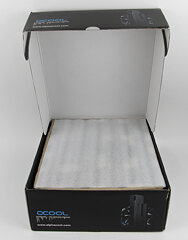 42
42
Alphacool Eiswolf 2 AIO GPU Cooler Review
Closer Examination »Packaging and Accessories
Alphacool had originally planned to do a series of different Eiswolf 2 AIOs for GPUs based on reference PCBs from NVIDIA and AMD, as well as for other GPUs from customers, such as ASUS, MSI, Gigabyte, ASRock, and so on. This review was thus meant to be representative of the entire Eiswolf 2 family, and also why I was sent an Eiswolf 2 AIO for the ASRock Radeon 5700XT Taichi. The GPU block aside, everything else remains identical, so we should be good to go. Note also that the actual product packaging is meant for their Eisbaer Aurora CPU AIO as the packaging for the Eiswolf 2 had not been finalized yet, so I am showing a stock photo of what it will look like when it is launched shortly. The design and color scheme are in line with other recent Alphacool launches, especially other CPU coolers, AIOs, and kits, with a large cardboard box that opens from the side to reveal the contents placed inside a shaped cardboard box. There is a thin sheet of foam above to add some protection during transit.
There are several components in this AIO, which comes separately packed for safer transportation without kinking the tubing and risking a leak. This is one of the benefits of going with soft tubing and quick disconnects, with it also making installation easier. Alphacool includes a product manual that is SKU-specific with installation instructions for the compatible GPUs (example manual for the NVIDIA RTX series AIO here). A thin cardboard box also contains the installation hardware, including a tube of thermal paste, screws and nuts, additional low-profile stop plugs, and a plastic tool to help install/remove these stop plugs. Not pictured here are longer screws to install the fans onto the radiator itself, which also come included in the package as expected.
The other accessories include more installation equipment, such as thermal pads, which come clearly marked for thickness and are referred to as such in the manual. Alphacool also includes an RGB LED adapter cable to connect the LEDs to compatible motherboard LED headers, as well as a simple standalone controller for preset lighting effects that is powered off a SATA connector straight from the PSU.
Feb 23rd, 2025 07:06 EST
change timezone
Latest GPU Drivers
New Forum Posts
- Cooler for r7 5700X3D [Stock] (5)
- Keep a 4080s or take a 5070ti? (33)
- Sapphire NITRO+ RX 5700 XT BE original BIOS request (3)
- RTX 5070 Ti Benelux pricing. It hurts (18)
- What are you playing? (22978)
- Advice needed for buying a new PSU (7)
- EFI partition too small, can't update Windows 11 on laptop (2)
- It's happening again, melting 12v high pwr connectors (886)
- 5800X3D CO and RAM - Thoughts? (15)
- The Vega VII Owners Club (109)
Popular Reviews
- MSI GeForce RTX 5070 Ti Ventus 3X OC Review
- ASUS GeForce RTX 5070 Ti TUF OC Review
- Ducky One X Inductive Keyboard Review
- Galax GeForce RTX 5070 Ti 1-Click OC White Review
- MSI GeForce RTX 5070 Ti Vanguard SOC Review
- darkFlash DY470 Review
- Gigabyte GeForce RTX 5090 Gaming OC Review
- MSI GeForce RTX 5070 Ti Gaming Trio OC+ Review
- Palit GeForce RTX 5070 Ti GameRock OC Review
- Fantech Aria II Pro Review
Controversial News Posts
- NVIDIA GeForce RTX 5090 Spotted with Missing ROPs, NVIDIA Confirms the Issue, Multiple Vendors Affected, RTX 5070 Ti, Too (425)
- AMD Radeon 9070 XT Rumored to Outpace RTX 5070 Ti by Almost 15% (302)
- AMD Plans Aggressive Price Competition with Radeon RX 9000 Series (271)
- AMD Radeon RX 9070 and 9070 XT Listed On Amazon - One Buyer Snags a Unit (247)
- Edward Snowden Lashes Out at NVIDIA Over GeForce RTX 50 Pricing And Value (241)
- AMD Denies Radeon RX 9070 XT $899 USD Starting Price Point Rumors (239)
- New Leak Reveals NVIDIA RTX 5080 Is Slower Than RTX 4090 (215)
- NVIDIA Investigates GeForce RTX 50 Series "Blackwell" Black Screen and BSOD Issues (184)











